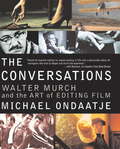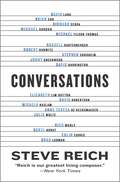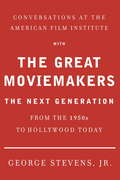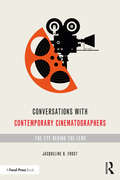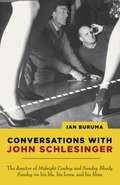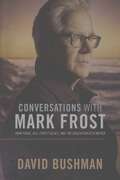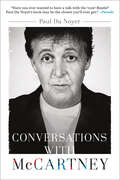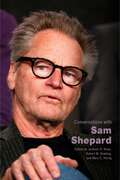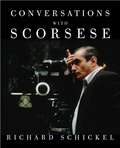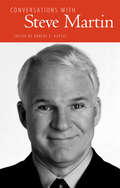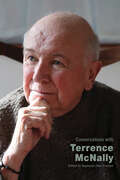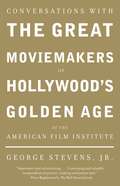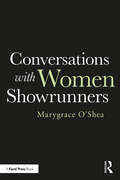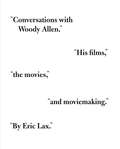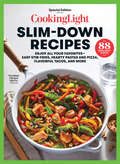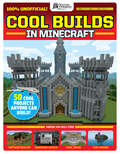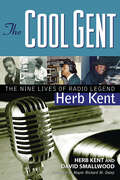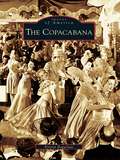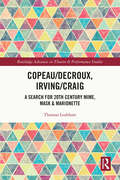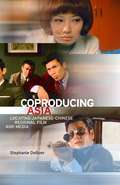- Table View
- List View
The Conversations: Walter Murch and the Art of the Editing Film
by Michael OndaatjeThe Conversations is a treasure, essential for any lover or student of film, and a rare, intimate glimpse into the worlds of two accomplished artists who share a great passion for film and storytelling, and whose knowledge and love of the crafts of writing and film shine through. It was on the set of the movie adaptation of his Booker Prize-winning novel, The English Patient, that Michael Ondaatje met the master film and sound editor Walter Murch, and the two began a remarkable personal conversation about the making of films and books in our time that continued over two years. From those conversations stemmed this enlightened, affectionate book -- a mine of wonderful, surprising observations and information about editing, writing and literature, music and sound, the I-Ching, dreams, art and history. The Conversations is filled with stories about how some of the most important movies of the last thirty years were made and about the people who brought them to the screen. It traces the artistic growth of Murch, as well as his friends and contemporaries -- including directors such as Francis Ford Coppola, George Lucas, Fred Zinneman and Anthony Minghella -- from the creation of the independent, anti-Hollywood Zoetrope by a handful of brilliant, bearded young men to the recent triumph of Apocalypse Now Redux. Among the films Murch has worked on are American Graffiti, The Conversation, the remake of A Touch of Evil, Julia, Apocalypse Now, The Godfather (all three), The Talented Mr. Ripley, and The English Patient. "Walter Murch is a true oddity in Hollywood. A genuine intellectual and renaissance man who appears wise and private at the centre of various temporary storms to do with film making and his whole generation of filmmakers. He knows, probably, where a lot of the bodies are buried."From the Trade Paperback edition.
Conversations
by Steve ReichA surprising, enlightening series of conversations that shed new light on the music and career of &“our greatest living composer&” (New York Times)Steve Reich is a living legend in the world of contemporary classical music. As a leader of the minimalist movement in the 1960s, his works have become central to the musical landscape worldwide, influencing generations of younger musicians, choreographers and visual artists. He has explored non-Western music and American vernacular music from jazz to rock, as well as groundbreaking music and video pieces. He toured the world with his own ensemble and his compositions are performed internationally by major orchestras and ensembles.Now Reich speaks with collaborators, fellow composers and musicians as well as visual artists influenced by his work to reflect on his prolific career as a composer as well as the music that inspired him and that has been inspired by him, including:David LangBrian EnoRichard SerraMichael GordonMichael Tilson ThomasRussell HartenbergerRobert HurwitzStephen SondheimJonny GreenwoodDavid HarringtonElizabeth Lim-DuttonDavid RobertsonMicaela HaslamAnne Teresa de KeersmaekerJulia WolfeNico MuhlyBeryl KorotColin CurrieBrad LubmanThrough this series of insightful, wide-ranging conversations starting from his student days to the present pandemic, we gain a compelling glimpse into the mind of &“the most original musical thinker of our time&” (The New Yorker).
Conversations at the American Film Institute with the Great Moviemakers
by George Stevens Jr.A companion volume to George Stevens, Jr.'s, much admired book of American Film Institute seminars with the great pioneering moviemakers ("Invaluable"--Martin Scorsese).Those represented here--directors, producers, writers, actors, cameramen, composers, editors--are men and women working in pictures, beginning in 1950, when the studio system was collapsing and people could no longer depend on, or were bound by, the structure of studio life to make movies. Here also are those who began to work long after the studio days were over--Robert Altman, David Lynch, Steven Spielberg, among them--who talk about how they came to make movies on their own. Some--like Peter Bogdanovich, Nora Ephron, Sydney Pollack, François Truffaut--talk about how they were influenced by the iconic pictures of the great pioneer filmmakers. Others talk about how they set out to forge their own paths--John Sayles, Roger Corman, George Lucas, et al. In this series of conversations held at the American Film Institute, all aspects of their work are discussed. Here is Arthur Penn, who began in the early 1950s in New York with live TV, directing people like Kim Stanley and such live shows as Playhouse 90, and on Broadway, directing Two for the Seesaw and The Miracle Worker, before going on to Hollywood and directing Mickey One and Bonnie and Clyde, among other pictures, talking about working within the system. ("When we finished Bonnie and Clyde," says Penn, "the film was characterized rather elegantly by one of the leading Warner executives as a 'piece of shit' . . . It wasn't until the picture had an identity and a life of its own that the studio acknowledged it was a legitimate child of the Warner Bros. operation.") Here in conversation is Sidney Poitier, who grew up on an island without paved roads, stores, or telephones, and who was later taught English without a Caribbean accent by a Jewish waiter, talking about working as a janitor at the American Negro Theater in exchange for acting lessons and about Hollywood: It "never really had much of a conscience . . . This town never was infected by that kind of goodness." Here, too, is Meryl Streep, America's premier actress, who began her career in Julia in 1977, and thirty odd years later, at sixty, was staring in The Iron Lady, defying all the rules about "term limits" and a filmmaking climate tyrannized by the male adolescent demographic . . . Streep on making her first picture, and how Jane Fonda took her under her wing ("That little line on the floor," Fonda warned Streep, "don't look at it, that's where your toes are supposed to be. And that's how you'll be in the movie. If they're not there, you won't be in the movie"). Streep on the characters she chooses to play: "I like to defend characters that would otherwise be misconstrued or misunderstood." The Next Generation is a fascinating revelation of the art of making pictures.
Conversations with Contemporary Cinematographers: The Eye Behind the Lens
by Jacqueline B FrostPacked with gems of wisdom from the current 'masters of light’, this collection of conversations with twenty leading contemporary cinematographers provides invaluable insight into the art and craft of cinematography. Jacqueline Frost’s interviews provide unprecedented insight into the role as cinematographers discuss selecting projects, the conceptual and creative thinking that goes into devising a visual strategy, working with the script, collaborating with leading directors such as Martin Scorcese, Spike Lee, and Ava DuVernay, the impact of changing technology, and offer advice for aspiring cinematographers. Interviews include Maryse Alberti, John Bailey, Robert Elswit, Kirsten Johnson, Kira Kelly, Ellen Kuras, Edward Lachman, Matthew Libatique, John Lindley, Seamus McGarvey, Reed Morano, Polly Morgan, Rachel Morrison, Rodrigo Prieto, Cynthia Pusheck, Harris Savides, Nancy Schrieber, John Seale, Sandi Sissel, Dante Spinotti, Salvatore Totino, Amy Vincent and Mandy Walker. Filled with valuable information and advice for aspiring cinematographers, directors, and filmmakers, this is essential reading for anyone interested in the art and craft of cinematography.
Conversations with John Schlesinger
by Ian Buruma"I like the surprise of the curtain going up, revealing what's behind it." -John Schlesinger. The British director John Schlesinger was one of the cinema's most dynamic and influential artists. Now, in Conversations with John Schlesinger, acclaimed writer Ian Buruma, Schlesinger's nephew, reveals the director's private world in a series of in-depth interviews conducted in the later years of the director's life. Here they discuss the impact of Schlesinger's personal life on his art. As his films so readily demonstrate, Schlesinger is a wonderful storyteller, and he serves up fascinating and provocative recollections of growing up in a Jewish family during World War II, his sexual coming-of-age as a gay man in conformist 1950s England, his emergence as an artist in the "Swinging 60s," and the roller-coaster ride of his career as one of the most prominent Hollywood directors of his time. Schlesinger also discusses his artistic philosophy and approach to filmmaking, recounting stories from the sets of his masterpieces, including Midnight Cowboy; Sunday, Bloody Sunday; Marathon Man; and The Day of the Locust. He shares what it was like to direct such stars as Dustin Hoffman, John Voight, Sean Penn, Madonna, and Julie Christie (whom Schlesinger is credited with discovering) and offers his thoughts on the fickle nature of fame and success in Hollywood. Packed with wit and keen insight into the artistic mind, Conversations with John Schlesinger is not just the candid story of a dynamic and eventful life but the true measure of an extraordinary person.
Conversations With Mark Frost: Twin Peaks, Hill Street Blues, and the Education of a Writer
by David BushmanTwin Peaks co-creator Mark Frost dishes about his long and storied career, including his time as a stagehand at Mister Rogers' Neighborhood ; his early days as a a young bachelor in Hollywood rooming with Adam Arkin and Michael O'Keefe; his brief time at Universal TV before chucking it all away to return home to Minnesota to work on documentaries; his experiences in the infamous Hill Street Blues writing room with Steven Bochco and David Milch; and, finally, his career-defining collaboration with David Lynch on Twin Peaks.Mark Frost, cocreator of both the original Twin Peaks and The Return, is often lost in the shadow of co-creator David Lynch in the eyes of critics and scholars -- one newspaper even called him the "Other Peak." In fact, Frost played at least as crucial a role in developing the narrative, mythology, and aesthetic of what has come to be revered as one of the most artful and influential shows ever to air on television. This book, comprising a series of interviews with Frost over the course of a single year, finally and fully acknowledges the extent of Frost's contributions not only to those series, but also to American television in general, as a writer/producer on Hill Street Blues and other shows, and as a mentor to numerous other writers. The book traces the arc of his entire life and career, from his boyhood days in New York, Los Angeles, and Minneapolis, to his nascent playwriting career in Pittsburgh, to his days as a writer at Universal TV's famed factory of the seventies, to his work on Hill Street Blues alongside such industry titans as Steven Bochco and David Milch, to his multiple collaborations with the famously enigmatic Lynch, who perhaps emerges as slightly less enigmatic in the pages of this book. Conversations with Mark Frost deconstructs that legendary partnership, while at the same time exploring Frost's values, influences, thematic preoccupations, and approach to creating art -- for the screen, the stage, and the printed page -- as well as his thoughts about such topics as politics, extraterrestrial life, ethics, and the future of the human race.
Conversations with McCartney
by Paul Du NoyerThe intimate portrayal of one of the most famous men in music, more than half of which is in McCartney's own words. In June 1989, Paul Du Noyer was contacted by Paul McCartney's office in London. They asked him to interview the star; McCartney and Du Noyer had met once before and enjoyed a good rapport. In the years that followed, Paul Du Noyer continued to meet, interview and work for Paul McCartney on a regular basis, producing magazine articles, tour programs, album liner notes, press materials, and editorial content for McCartney's website. Du Noyer has spent more hours in formal, recorded conversation with McCartney than any other writer. Conversations with McCartney is the culmination of Du Noyer's long association with McCartney and his music. Drawing from their interview sessions across 35 years and coupling McCartney's own, candid thoughts with Du Noyer's observations and analysis, Conversations with McCartney is beautifully written--a sensitive, shrewd portrait of one of the most accomplished artists of our time.
Conversations with Sam Shepard (Literary Conversations Series)
by Jackson R. Bryer, Robert M. Dowling, and Mary C. HartigA prolific playwright, Sam Shepard (1943–2017) wrote fifty-six produced plays, for which he won many awards, including a Pulitzer Prize. He was also a compelling, Oscar-nominated film actor, appearing in scores of films. Shepard also published eight books of prose and poetry and was a director (directing the premiere productions of ten of his plays as well as two films); a musician (a drummer in three rock bands); a horseman; and a plain-spoken intellectual. The famously private Shepard gave a significant number of interviews over the course of his public life, and the interviewers who respected his boundaries found him to be generous with his time and forthcoming on a wide range of topics. The selected interviews in Conversations with Sam Shepard begin in 1969 when Shepard, already a multiple Obie winner, was twenty-six and end in 2016, eighteen months before his death from complications of ALS at age seventy-three. In the interim, the voice, the writer, and the man evolved, but there are themes that echo throughout these conversations: the indelibility of family; his respect for stage acting versus what he saw as far easier film acting; and the importance of music to his work. He also speaks candidly of his youth in California, his early days as a playwright in New York City, his professionally formative time in London, his interests and influences, the mythology of the American Dream, his own plays, and more. In Conversations with Sam Shepard, the playwright reveals himself in his own words.
Conversations with Scorsese
by Richard SchickelMean Streets, Taxi Driver, Raging Bull, The Last Temptation of Christ, Kundun, The Departed, The Aviator, Shutter Island: these are just a few of the critically acclaimed films, startling experimental works, and spectacular commercial blockbusters with which Martin Scorsese has forever enriched American cinema. Here is a rare and wonderfully insightful chance to experience all of these films, and the history and process of moviemaking in general, through the words and wit of the master director. Richard Schickel's canny and intelligent interviews guide us through Scorsese's life and work, from the child who escaped the realities of Little Italy in the 1950s through movies to the man whose increasingly encyclopedic knowledge of film shaped his ambitions and art. Scorsese reveals which films are most autobiographical and which have been forays into unknown territory in content or aesthetics. He talks about his lesser-known movies, those already considered classics, his documentaries, and his influences. He explains his personal style, the close attention he pays to detail, and his attraction to genre films. And he discusses what being a lifelong student of film has taught him about acting, directing, music, and camerawork, among many other topics. The result is a vivid, immensely enlightening history of modern Hollywood seen through the eyes of one intrepid filmmaker. We see audiences' expectations tested by what Scorsese was willing to put on the screen in explorations of prostitution, institutionalized violence, and religion. We see the unavoidable frustrations and exhilarating rewards of filming live concerts for The Band and at Woodstock. And we see many of the rewarding artistic and personal relationships of Scorsese's career, including collaborations with Robert De Niro, Harvey Keitel, Jack Nicholson, and Leonardo DiCaprio. An invaluable appreciation of one of our most admired film directors.
Conversations with Steve Martin (Literary Conversations Series)
by Robert E. KapsisConversations with Steve Martin presents a collection of interviews and profiles that focus on Martin as a writer, artist, and original thinker over the course of more than four decades in show business. While those less familiar with his full body of work may think of Martin as primarily the "wild and crazy guy" with an arrow through his head, this book makes the case that he is in fact one of our nation's most accomplished and varied artists. It shows the full range of Martin's creative work, tracing the source of his comic imagination from his early standup days, starting in the mid to late 1960s through the films he has written and starred in, and emphasizing his more recent creative outpourings as playwright, essayist, novelist, memoirist, songwriter, composer, musician, and art critic. “Standup is the hardest material in the world to write for someone else; it's like trying to condense 10 years of experience into 20 minutes of new material,” Martin says. But commenting on his fiction writing, he says. “I think you have to be able to find as a writer that state where you don't know what you're going to say or what the character is going to say or who the characters are. That's the biggest thrill of all. When you start to trust that subconscious thing and you don't censor yourself—just remember you can always throw it away that's when the good stuff comes out.” The selected materials consist not only of pieces focused primarily on Martin's writings, but also broader profiles and conversations that help explain Martin's development as a writer within the larger context of his many other accomplishments, talents, and performance skills.
Conversations with Terrence McNally (Literary Conversations Series)
by Raymond-Jean FrontainArriving in New York at the tail end of what has been termed the “Golden Age” of Broadway and the start of the Off-Broadway theater movement, Terrence McNally (1938–2020) first established himself as a dramatist of the absurd and a biting social critic. He quickly recognized, however, that one is more likely to change people’s minds by first changing their hearts, and—in outrageous farces like The Ritz and It’s Only a Play—began using humor more broadly to challenge social biases. By the mid-1980s, as the emerging AIDS pandemic called into question America’s treatment of persons isolated by suffering and sickness, he became the theater’s great poet of compassion, dramatizing the urgent need of human connection and the consequences when such connections do not take place. Conversations with Terrence McNally collects nineteen interviews with the celebrated playwright. In these interviews, one hears McNally reflect on theater as the most collaborative of the arts, the economic pressures that drive the theater industry, the unique values of music and dance, and the changes in American theater over McNally’s fifty-plus year career. The winner of four competitive Tony Awards as the author of the Best Play (Love! Valour! Compassion! and Master Class) and author of the book for the Best Musical (Kiss of the Spider Woman and Ragtime), McNally holds the distinction of being one of the few writers for the American theater who excelled in straight drama as well as musical comedy. In addition, his canon extends to opera; his collaboration with composer Jake Heggie, Dead Man Walking, has proven the most successful new American opera of the last twenty-five years.
Conversations with the Great Moviemakers of Hollywood's Golden Age: At the American Film Institute
by George Stevens Jr.The first book to bring together these interviews of master moviemakers from the American Film Institute's renowned seminars,Conversations with the Great Moviemakers offers an unmatched history of American cinema in the words of its greatest practitioners. Here are the incomparable directors Frank Capra, Elia Kazan, King Vidor, David Lean, Fritz Lang ("I learned only from bad films"), William Wyler, and George Stevens; renowned producers and cinematographers; celebrated screenwriters Ray Bradbury and Ernest Lehman; as well as the immortal Ingmar Bergman and Federico Fellini ("Making a movie is a mathematical operation. It's absolutely impossible to improvise"). Taken together, these conversations offer uniquely intimate access to the thinking, the wisdom, and the genius of cinema's most talented pioneers.
Conversations with Women Showrunners
by Marygrace O'SheaFeaturing over forty interviews with America’s leading showrunners, this book provides unique perspectives and insights into the TV industry, demystifying the craft, backbone, skill, strategies, challenges, and persistence it takes to succeed in Hollywood and internationally. Marygrace O’Shea’s conversations with women showrunners are part master craft lesson, part backstage pass, part career guide from the geniuses who create the best TV. The book shines a light on what it truly means to be a showrunner working in the industry today, and reveals how to navigate a career and a future in the global marketplace. Interviews include Angela Kang (The Walking Dead), Aline Brosh McKenna (Crazy Ex-Girlfriend), Barbara Hall (Madam Secretary), Charlotte Brown (Rhoda), Chris Nee (Doc McStuffins), Elizabeth Berger (This is Us), Gloria Calderón Kellett (One Day at a Time), Ilene Chaiken (The L Word), Liz Meriwether (The New Girl, The Dropout), Liz Tigelaar (Tiny Beautiful Things, Little Fires Everywhere), Marta Kauffman (Friends, Grace and Frankie), Tracy Oliver (Harlem, Awkward Black Girl), Sierra Teller Ornelas (Rutherford Falls), and many more. Ideal for professional and aspiring television writers, as well as students of screenwriting, film and TV, this book is essential reading for anyone interested in the art, craft and business of creating television.
Conversations with Woody Allen
by Eric LaxFrom the author of the best-selling biography Woody Allen--the most informative, revealing, and entertaining conversations from his thirty-six years of interviewing the great comedian and filmmaker.For more than three decades, Woody Allen has been talking regularly and candidly with Eric Lax, and has given him singular and unfettered access to his film sets, his editing room, and his thoughts and observations. In discussions that begin in 1971 and continue into 2007, Allen discusses every facet of moviemaking through the prism of his own films and the work of directors he admires. In doing so, he reveals an artist's development over the course of his career to date, from joke writer to standup comedian to world-acclaimed filmmaker.Woody talks about the seeds of his ideas and the writing of his screenplays; about casting and acting, shooting and directing, editing and scoring. He tells how he reworks screenplays even while filming them. He describes the problems he has had casting American men, and he explains why he admires the acting of (among many others) Alan Alda, Marlon Brando, Michael Caine, John Cusack, Judy Davis, Robert De Niro, Leonardo DiCaprio, Mia Farrow, Gene Hackman, Scarlett Johansson, Julie Kavner, Liam Neeson, Jack Nicholson, Charlize Theron, Tracey Ullman, Sam Waterston, and Dianne Wiest. He places Diane Keaton second only to Judy Holliday in the pantheon of great screen comediennes.He discusses his favorite films (Citizen Kane is the lone American movie on his list of sixteen "best films ever made"; Duck Soup and Airplane! are two of his preferred "comedian's films"; Trouble in Paradise and Born Yesterday among his favorite "talking plot comedies"). He describes himself as a boy in Brooklyn enthralled by the joke-laden movies of Bob Hope and the sophisticated film stories of Manhattan. As a director, he tells us what he appreciates about Bergman, De Sica, Fellini, Welles, Kurosawa, John Huston, and Jean Renoir. Throughout he shows himself to be thoughtful, honest, self-deprecating, witty, and often hilarious.Conversations with Woody Allen is essential reading for everyone interested in the art of moviemaking and for everyone who has enjoyed the films of Woody Allen.From the Hardcover edition.
Cook It, Spill It, Throw It: The Not-So-Real Housewives Parody Cookbook
by Stuart O'Keeffe Amy PhillipsCelebrity chef Stuart O'Keeffe and comedian Amy Phillips razz the Real Housewives in this gorgeous cookbook filled with recipes inspired by iconic moments in the franchise’s rich history. With a foreword by Andy Cohen.“Cook It, Spill It, Throw It is an immersive, one-of-a-kind experience in a world we can’t escape (but let’s face it, we don’t want to!).” —from the foreword by Andy CohenTrends come and go, but watching rich women drink and catfight is forever. Which is why after more than a decade of airing, the Real Housewives phenomenon continues to reign supreme in the pop culture stratosphere. Week after week, season after season, loyal fans watch the thrilling drama—the backstabbing, the gossiping, the screaming, the table flipping, the wine tossing—unfold. Cook It, Spill It, Throw It is a cookbook created specifically for Housewives fans. Chef Stuart O’Keeffe and comedian Amy Phillips—long-time devotees themselves—have dreamed up an inviting menu served with a side of delicious snark.Inspired by the series and its stars, the dishes and drinks evoke familiar moments of chaos from the franchise. Whether you’re looking to make Ponytail Pulled Pork, or you want to comfort a friend in the Caicos with Eggs a Lu’Francais, there’s a meal for you—and there are definitely plenty of drinks (including Henny-thing Can Happen and the classic Singer Stinger Sipper).Featuring gorgeous original photography and equally gorgeous recipes, Cook It, Spill It, Throw It is the must-have cookbook and companion for every Housewives addict.
The Cookie Company
by Ross VenokurWhen the unluckiest boy in the world turns thirteen, even more bad luck is sure to follow. So when a mysterious Chinese-food deliveryman appears on Alex Grindlay’s doorstep with a surprise birthday dinner, Alex knows better than to expect a good fortune in his fortune cookie dessert. But even Alex couldn’t have predicted the crazy adventures that lie ahead of him. Just his luck: One little fortune cookie changes his life forever. Alex is whisked into a world where anything can happen, and the fortune in his cookie is his only clue to the route home. As if that isn’t bad enough, he’s pursued relentlessly by Cypress Vine, an evil game show host who wants to take over Alex’s world. All she needs is a way to get out of her world and into his--and a magical cookie will do the trick nicely. With all his bad luck, how on earth can Alex stop a superpowerful game show host? He’d better figure it out soon if he ever wants to get home.
COOKING LIGHT Slim-Down Recipes: 88 Indulgent Dishes
by The Editors of Cooking LightWhether you're looking to shed a few pounds, feel refreshed, or simply make healthier lifestyle choices, better-for-you options don't have to mean boring meals.
The Cool and the Crazy: Pop Fifties Cinema
by Professor Peter StanfieldExplosive! Amazing! Terrifying! You won't believe your eyes! Such movie taglines were common in the 1950s, as Hollywood churned out a variety of low-budget pictures that were sold on the basis of their sensational content and topicality. While a few of these movies have since become canonized by film fans and critics, a number of the era's biggest fads have now faded into obscurity. The Cool and the Crazy examines seven of these film cycles, including short-lived trends like boxing movies, war pictures, and social problem films detailing the sordid and violent life of teenagers, as well as uniquely 1950s takes on established genres like the gangster picture. Peter Stanfield reveals how Hollywood sought to capitalize upon current events, moral panics, and popular fads, making movies that were "ripped from the headlines" on everything from the Korean War to rock and roll. As he offers careful readings of several key films, he also considers the broader historical and commercial contexts in which these films were produced, marketed, and exhibited. In the process, Stanfield uncovers surprising synergies between Hollywood and other arenas of popular culture, like the ways that the fashion trend for blue jeans influenced the 1950s Western. Delivering sharp critical insights in jazzy, accessible prose, The Cool and the Crazy offers an appreciation of cinema as a "pop" medium, unabashedly derivative, faddish, and ephemeral. By studying these long-burst bubbles of 1950s "pop," Stanfield reveals something new about what films do and the pleasures they provide.
Cool Builds in Minecraft!: An AFK Book (GamesMaster Presents)
by Future Future PublishingGet building today! This book is full of cool Minecraft projects and awesome advice that will help you become a master builder in no time.Get building today! For those who want to master the most important and most challenging aspect of Minecraft, GamesMaster Presents: Cool Builds in Minecraft! is the definitive book out there that covers mining resources to crafting buildings, vehicles and even entire worlds. Perfect for players of all ages who want to improve their crafting skills, this book will take you all the way from crafting your first shelter, to putting the finishing touches to your very own mega-build masterclasses. Includes full-color images and step-by-step instructions for 50 cool Minecraft builds. 100% unofficial. Created by Future plc and GamesMaster, leaders in video game publishing.
Cool Daddy Rat
by Kristyn CrowEvery night, Cool Daddy Rat takes his bass case and goes out to play jazz and scat around the city. But one night he hears something strange: Peeky squeaky who dat? It's his son, Ace, hiding in the bass case! After a reassuring call to Mama, the pair go all over the city together, filling the streets with his sweet beat. And when Ace can't contain himself any longer, Cool Daddy Rat finds out he's the best scatter in the family. Image descriptions present.
The Cool Gent: The Nine Lives of Radio Legend Herb Kent
by Herb Kent David Smallwood Mayor Richard M. DaleyWhen Herb Kent was a straight-A college student in the 1940s, his white professor told him, “You have the best voice in class, but you'll never make it in radio because you're a Negro.” This did not deter the poor kid from the Chicago housing projects who had decided on a radio career at age five. It was just one more obstacle to face head on and overcome. Known as the Cool Gent, the King of the Dusties, and the Mayor of Bronzeville, Herb Kent is one of radio's most illustrious and legendary stars. This fascinating autobiography details both the high and low points of Herb's life while providing a vivid picture of black music, culture, and personalities from the 1950s to today. Herb had a typical rock-and-roll lifestyle—drugs, alcohol, all-night partying, and women—eventually hitting rock bottom, where he finally faced his personal demons. At least nine times Herb came close to death, but through it all, he maintained his debonair, classy persona and his uncanny knack for picking timeless tunes. And he didn't save only himself; along the way, he blazed new trails for all African Americans and remains a role model for today's top deejays.
Copacabana, The
by Kristin BaggelaarIt has been years since New York has seen anything quite like the old Copacabana. The Copa, Manhattan's best-known night club, was also the most popular nightspot in America. From the moment it burst onto the scene in 1940, an aura of glamour and sophistication hovered over the Copa. It was a luminous glow that, over the course of five decades, served this illustrious establishment well, beckoning the people who made it famous-Hollywood stars, sports heroes, foreign dignitaries, and the town's leading families, including the Kennedys, the Roosevelts, and the Du Ponts. The Copa was a showcase for past, present, and future stars, including Joe E. Lewis, Sophie Tucker, Jimmy Durante, Julie Wilson, Tony Orlando, and Wayne Newton. Through vintage photographs and stories from performers, Copa Girls, and other people connected with the Copa's history, The Copacabana chronicles how this landmark institution became an American cultural icon.
Copeau/Decroux, Irving/Craig: A Search for 20th Century Mime, Mask & Marionette (Routledge Advances in Theatre & Performance Studies)
by Thomas G LeabhartIn this series of essays, Thomas Leabhart presents a thorough overview and analysis of Etienne Decroux’s artistic genealogy. After four years’ apprenticeship with Decroux, Thomas Leabhart began to research and discover how forebears and contemporaries might have influenced Decroux’s project. Decades of digging revealed striking correspondences that often led to adjacent fields—art history, philosophy, and anthropology—forays wherein Leabhart’s appreciation of Decroux and his "kinsfolk," who themselves transgressed traditional frontiers, increased. The following essays, composed over a 30-year period, find a common source in a darkened Prague cinema where people gasped at a wooden doll’s sudden reversal of fortune. These essays: investigate the source of that astonishment; continue Leabhart's examination of Decroux’s "family tree"; consider how Copeau's and Decroux's keen observation of animal movement influenced their actor training; record the challenging and paradoxical improvisations chez Decroux; and recall Decroux’s debt to sculpture, poster art, sport and masks. These essays will be of great interest to students, scholars and practitioners in theatre and performance studies.
Copland: 1900 Through 1942
by Aaron Copland Vivian PerlisThis memoir begins with Copland's Brooklyn childhood and takes us through his years in Paris, the creation of his early works, and his arrival at Tanglewood. Rich with remembrances from Leonard Bernstein, Virgil Thomson, and Nadia Boulanger, as well as a trove of letters, photographs, and scores from Copland's collection.
Coproducing Asia: Locating Japanese–Chinese Regional Film and Media
by Stephanie DeBoerEast Asia largely functions as a single film and media market, but behind it exists a multifaceted world of coproduction crossing linguistic and national borders. In Coproducing Asia, Stephanie DeBoer guides readers through a rich genealogy of regional film and media coproduction, all the while introducing innovative methods for their examination across decades, locations, and scales of production in East Asia and beyond.Beginning with the present and moving back in time, Coproducing Asia paints a picture of the assemblages of coproduction in East Asia and their negotiation of Cold War geopolitics and imperial legacies along with the emergence of China as a global market. Addressing wide-screen international romances of the early 1960s, technology transfers of Cold War action cinema, Sino–Japanese &“friendship&” TV collaborations, Asian omnibus film and video, and more recent China-centered blockbusters, DeBoer deftly contextualizes each case study while accounting for the difficulties involved in the cultural, creative, and industry mediations associated with coproduction. Based on rarely seen archival research as well as interviews with producers in Tokyo, Hong Kong, Taipei, and Shanghai, Coproducing Asia provides compelling frames for understanding the significance of film and media coproduction in East Asia, making clear that it is not only a site of technological transformation but also an arena for competing senses of regional location and place.
